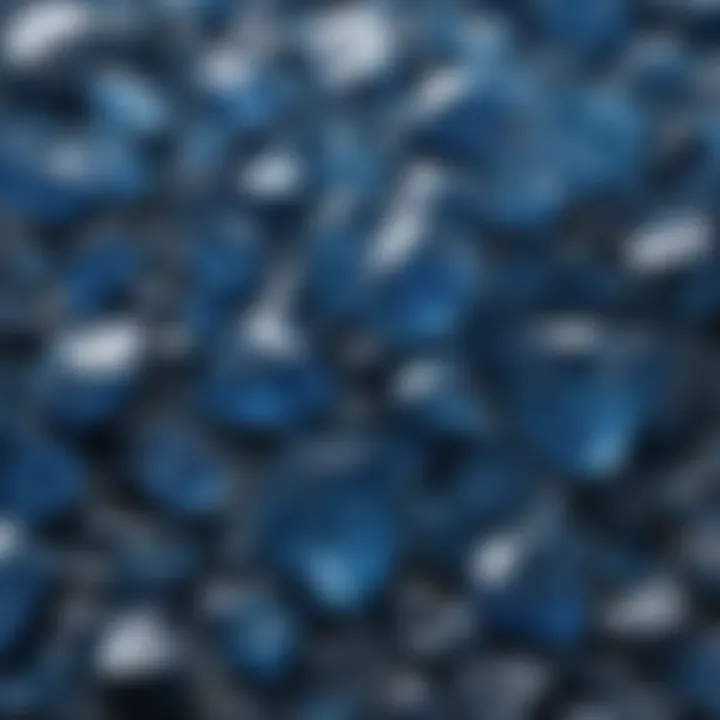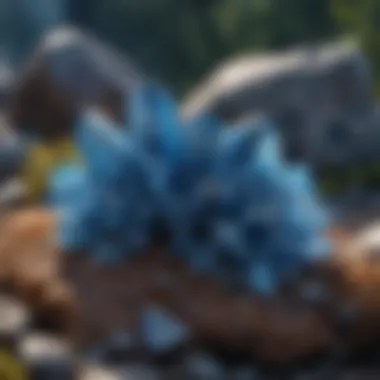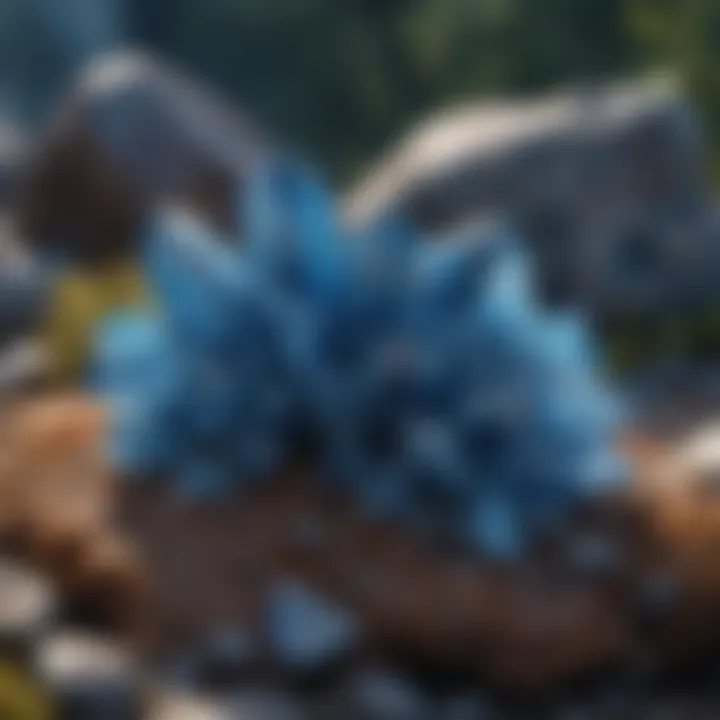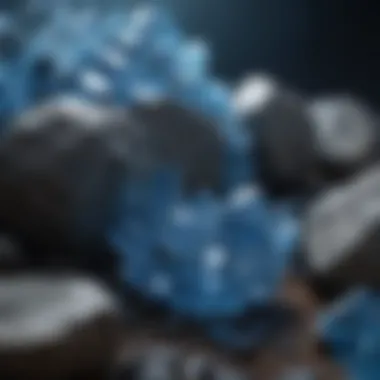Exploring the Beauty and Meaning of Blue Crystal Stones


Intro
Blue crystal stones exude a certain charm that captivates many. Their vibrant hues are not just geologic accidents; they tell stories of ancient formations, cultural interpretations, and personal significance. From lapis lazuli to aquamarine, each type comes with its own mystique.
These stones often find a place in both the realms of collectors and practitioners of alternative healing. The scientific properties of these stones, alongside their historical and cultural relevance, provide a backdrop that enriches their appeal.
The purpose of this article is to take you on a journey through the rich tapestry surrounding blue crystals, revealing their geological origins, identifying features, cultural meanings, and the care required for their preservation. By understanding these elements, you can appreciate their beauty and significance far deeper.
Featured Collectible of the Month
Overview
For this month, we spotlight the stunning Blue Kyanite. Known for its striking blue color, it forms in long, thin blades which shimmer under light. This crystal is quite prized among collectors, not only for its aesthetics but also for its unique properties.
Blue Kyanite is often used in meditation and energy work. Many believe it facilitates communication and self-expression, making it a favored choice for those on spiritual paths. Its beauty and metaphysical uses bring collectors and practitioners alike to seek it out.
Historical Significance
The allure of Blue Kyanite stretches back to ancient civilizations. In various cultures, it has been regarded as a protective stone that aids in balance and serenity. The Greeks often associated it with the goddess Athena—symbolizing wisdom and understanding. As a result, Kyanite has found its place in various historical artifacts and talismans.
Most interestingly, Kyanite does not hold a fixed price, often fluctuating based on size and color intensity. This variability in value adds an element of excitement to its collecting, as what may seem ordinary in form could be extraordinarily valuable with the right coloration.
"The uncharted potential of blue crystals not just graces our collection shelves but also connects with the history we often overlook."
Identification Techniques
Identifying blue crystal stones can be tricky, especially for newcomers. Here are some methods that can help you in distinguishing various types of blue crystals:
Visual Characteristics
- Color Variations: Pay attention to the shade and saturation of blue. Light blues may suggest stones like aquamarine, while deeper hues could hint at lapis lazuli.
- Transparency: Some blue crystals, like topaz, are translucent, while others, like sodalite, might be opaque.
- Texture: The feel of the stone can also tell you a lot. Smooth surfaces are common to polished stones, whereas rough textures may reveal natural specimens.
- Striations and Inclusions: Look for lines or tiny particles trapped within the crystal. These can be identifiers of specific blue stones.
Resources for Identification
- Gemological Institutes: Websites like www.britannica.com and www.en.wikipedia.org present informative articles on various stones including blue crystals.
- Forums: Online communities, especially on platforms like reddit.com or facebook.com, offer discussion boards where enthusiasts can share their insights and tips for identification.
In essence, diving into the world of blue crystals is not just about collecting; it's about understanding the stories they encapsulate and the beauty they add to our lives.
Prologue to Blue Crystal Stones
The study of blue crystal stones opens up a captivating chapter in the world of geology and spirituality. These stunning natural formations are not just beautiful to the eye; they carry a wealth of significance that transcends mere aesthetics. For rock and fossil collectors, delving into the allure of blue crystals offers an opportunity to appreciate both their physical properties and their cultural implications. In this section, we will establish a foundation for understanding what makes these gemstones so special.
Definition and Characteristics
Blue crystal stones, as a category, are defined by their striking azure hues that can range from deep navy to gentle sky tones. Many collectors are drawn to these stones for their unique characteristics. For instance, a stone like lapis lazuli exhibits a rich, velvety blue laced with golden pyrite flecks, creating a mesmerizing effect. Celestite, on the other hand, displays a more ethereal pale blue, reminiscent of a clear summer sky. Each stone tells its own story through color variations and inclusions, making them fascinating specimens for any collector.
When observing blue crystals, one must also consider their composition. Common minerals like sodium, aluminum, and sulfur play essential roles in creating these hues. Their distinct crystal structures, ranging from cubic in the case of sodalite to fibrous in blue kyanite, contribute not only to their appearance but also to their physical properties. Being able to identify these traits can enhance a collector’s understanding and appreciation.
Overview of Geological Formation
The formation of blue crystal stones is a process of remarkable complexity, shaped over millennia through natural phenomena. Most blue stones are formed in metamorphic rocks or sedimentary environments where specific conditions encourage the growth of particular minerals. For example, lapis lazuli forms primarily in limestone deposits, undergoing high pressure and temperatures which allow the vibrant colors to emerge.
Moreover, the geological history surrounding these stones often tells of significant Earth events, such as volcanic activity or tectonic shifts, which can influence not just their chemical makeup but also their location. Understanding these geological processes is paramount for collectors who seek quality specimens.
"Blue crystals are not just a feast for the eyes; they are a testament to the Earth’s complex and dynamic processes that have shaped our planet for eons."
In the end, exploring blue crystal stones unravels the remarkable symbiotic relationship between nature's artistry and geological science. From their vivid characteristics to the intricate formations, blue crystals invite us to delve deeper into both their beauty and the stories that they carry.
Types of Blue Crystal Stones
The world of blue crystal stones presents a fascinating array of types, each with its own unique properties, benefits, and stories. Understanding the different varieties of these crystals is essential for collectors and enthusiasts alike. When one dives into the details of each stone, it becomes clear how they not only enhance personal collections but also serve various purposes, ranging from healing to artistic expression.
Sodalite
Sodalite is often regarded as a stone of logic and truth. With its striking deep blue hue, it resembles the sky just before twilight. This stone is mainly composed of sodium and aluminum, along with some chloride, giving it its unique structure. It typically forms in metamorphic rocks and can be found in several locations, including Brazil and Canada.
The significance of sodalite lies in its believed ability to promote rational thinking and enhance communication. Many collectors appreciate this stone for its aesthetic appeal and also for its purported influence on clarity of thought. It is common to find sodalite used in various jewelry forms, including pendants and beads, making it both a beautiful and meaningful addition to any collection.


Celestite
Celestite, often called the stone of heaven, showcases a delicate, milky blue color that often leaves onlookers enchanted. This mineral tends to form in sedimentary environments, typically as a result of the evaporation of water. The primary components of celestite include barium sulfate, which contributes to its unique crystalline structure.
Collectors often seek celestite not just for its soft, peaceful appearance but also for its association with spirituality and serenity. Many believe it facilitates communication with higher frequencies, making it a popular choice among those practicing meditation or looking to enhance their spiritual experiences. Its delicate nature requires careful handling and storage, especially when displayed in its natural gemstone form.
Lapis Lazuli
Arguably one of the most sought-after blue stones, lapis lazuli has been treasured for centuries. Its deep azure color, often interspersed with flecks of gold-colored pyrite, captures the imagination and reflects a rich historical significance. Mostly sourced from Afghanistan, lapis lazuli has been used since ancient times for decorative arts and jewelry.
This stone is steeped in history and culture; it was highly regarded by the Egyptians who believed it brought wisdom and personal expression. For collectors, lapis lazuli is more than just a pretty stone; it is a piece of history, a connection to a time when it adorned the pharaohs. Its significance transcends aesthetics, as it is often utilized in holistic practices, believed to promote self-awareness and inner truth.
Blue Kyanite
Blue kyanite is distinctive not only for its vivid blue color but also for its unique crystal structure, which varies in hardness depending on the crystal's orientation. Found in various parts of the world, including Brazil and Nepal, this mineral is a favorite among collectors for its striking color and unique properties.
Kyanite is particularly prized for its ability to facilitate energy flow and communication. Collectors often seek this stone for its high vibration, claiming it can clear energy blockages and align the chakras. Due to its unique formation, it does not require cleansing like most other crystals, making it low-maintenance for collectors.
Geological Properties of Blue Crystals
Understanding the geological properties of blue crystal stones is crucial for any enthusiast or collector. These properties not only define the unique characteristics of each type but also provide insights into how they were formed and how they can be preserved over time. By delving into the depths of chemical composition, crystal structure, and physical attributes, we uncover the allure that these stunning specimens hold within the realm of geology.
Chemical Composition
The chemical composition of blue crystals plays a fundamental role in their formation and characteristics. Different elements combine in various proportions, leading to the formation of distinct minerals. For instance, lapis lazuli is primarily composed of lazurite, which is what gives it that deep azure hue. In contrast, sodalite includes sodium, which can alter its color slightly to a more vibrant tone. This variability in chemical makeup not only affects the visual appeal but also governs the properties of the stones, such as their hardness and density.
Understanding these variations helps collectors to appreciate the nuances of each type. When selecting pieces for a collection, recognizing the composition can guide choices in terms of aesthetic preferences or holistic applications.
Crystal Structure
The crystal structure of blue stones defines how they grow and the environment they thrive in. Most blue crystals exhibit a hexagonal structure, which influences their symmetry and cleavage. For example, blue kyanite showcases a unique arrangement that allows it to easily split along its layers, making it easy to shape for jewelry and other uses.
This property is essential because it determines not just aesthetics but also durability. Crystals with sturdy structures are more sought after, as they withstand wear and tear over time. Understanding the structural integrity can impact the market value significantly and is a cornerstone for collectors aiming to build robust collections.
Physical Attributes
Hardness
The hardness of a blue crystal is measured on the Mohs scale, which assesses how resistant a mineral is to scratching. For instance, lapis lazuli ranks around 5 to 5.5, making it relatively soft compared to crystals like sodalite, which can reach 5.5 to 6. This property is vital for determining how a stone will be used.
Choosing a harder stone can be beneficial for projects requiring durability, such as cabochons or carving. Conversely, softer stones, while easier to work with, may not hold up as well in jewelry that receives daily use. Understanding hardness can save collectors from making regrettable choices.
Transparency
Transparency in blue crystals varies widely, creating a spectrum from nearly opaque to richly transparent gems. Take celestite, for example; it often displays a translucent quality that enhances its ethereal appearance, making it highly desirable for collectors. In contrast, sodalite leans towards the opaque side, with vivid blue specks that create captivating patterns.
Evaluating transparency helps collectors appreciate the light's play on the stones. Crystals with better transparency can sometimes command higher prices due to their visual appeal and rarity.
Color Variations
The color variations among blue crystals range from cobalt blue to lighter sky tones. Different geological environments impart unique shades; for instance, the variations in cobalt and other trace elements determine the specific hue. Lapis lazuli, for example, can display flecks of gold and vibrant blues, while blue kyanite often leans towards a deeper cobalt appearance.
In collecting, these colors are vital markers of authenticity and can indicate the origin of the stone. Possessing a broader range of colors not only brings visual diversity to a collection but can also enhance emotional connection for the collector.
"Each blue crystal tells a story, from its formation deep within the Earth to its place in human culture and personal experience."
The geological properties of blue crystals contribute greatly to their significance in the world of collecting. By understanding the intricacies of their chemical composition, crystal structure, and physical attributes, collectors can make informed decisions that enhance their appreciation and enjoyment of these striking geological artifacts. Engaging with their unique properties leads to a deeper connection and a greater understanding of the beauty hidden within each stone.
Cultural and Historical Significance
The cultural and historical significance of blue crystal stones resonates through time, encompassing vast realms of human experience. These gemstones are not mere geological formations; they are intertwined with ancient stories, societal beliefs, and significant practices that have shaped civilizations. Understanding this significance can deepen one's appreciation of blue crystals, offering insight into their multifaceted roles beyond mere aesthetics.
Use in Ancient Civilizations
From ancient Egypt to the realms of Mesopotamia, blue crystals held a revered place. Egyptians often used lapis lazuli, a striking deep blue stone, not just as a piece of jewelry but also in burial masks and as a symbol of royalty. Its beauty was matched only by its believed protective properties. They associated the stone with the sky and the heavens, reflecting the culture's connection between the divine and earthly realms.
Additionally, the Sumerians considered blue stones valuable, utilizing them in amulets that were thought to ward off evil. They believed that wearing these gems would invite the blessings of gods, offering spiritual protection against dangers. This use of blue crystals was a common thread, interlinking many ancient societies who viewed them as conduits between the mundane and the miraculous.
"In ancient cultures, blue crystals were not only treasured for their beauty but were also viewed as talismans that spoke to the human desire for protection and connection to the divine."


Moreover, ancient Chinese civilizations valued the virtues of blue stones like blue kyanite and celestite in their healing practices. These stones were often ground into powders for medicinal purposes or placed in gardens as protectors against negative energies. Their appreciation for the natural world extended to believing that these gems could influence not just physical health but emotional well-being.
Symbolism and Beliefs
The symbolism woven into the fabric of blue crystals is rich and diverse. For many cultures, the color blue itself signifies calmness, serenity, and trust. These traits contributed to their association with wisdom, healing, and peace. For instance, lapis lazuli is often linked with truth and enlightenment — a representation of the journey toward self-awareness and clarity. In contemporary settings, individuals often turn to this stone to enhance their communication skills and express their inner thoughts more clearly.
Different crystals are attributed to various spiritual meanings and purposes. Sodalite, too, is renowned for fostering logical thinking and helping with mental clarity. This is especially beneficial for those engaged in endeavors requiring creativity or analytical prowess. It becomes a tool, reminding individuals of the harmony that can exist between mind and spirit.
In modern spiritual practices, blue crystals are still cherished. They are frequently used in rituals to manifest tranquility or enhance intuitive abilities. Many believe that they can facilitate meditation by creating a peaceful aura, allowing for deeper introspection and enlightenment. The act of holding or wearing these stones can feel like an embrace from the universe, reminding the wearer of their connection to something larger.
Blue Crystals in Holistic Practices
The connection between blue crystals and holistic practices offers a fascinating glimpse into the interplay of geology and personal well-being. For many enthusiasts, these stones are more than mere decorative pieces; they symbolize a bridge between the natural world and the healing realms of mind and spirit. Engaging with blue crystals can provide various benefits, from emotional balance to enhanced clarity in thought. Collectors, in particular, may find that understanding these aspects enriches their appreciation of their collections and infuses each stone with a deeper meaning.
Healing Properties
Blue crystals, such as Lapis Lazuli or Blue Kyanite, are often celebrated for their purported healing properties. These stones are said to resonate with energies that promote calmness and soothe anxiety.
Here are some key healing attributes often attributed to blue crystals:
- Emotional Balance: These crystals are thought to help harness chaotic emotions, encouraging serenity and patience.
- Communication Enhancement: Often linked to the throat chakra, blue stones like Sodalite are believed to foster effective communication skills.
- Stress Relief: The calming hues of these stones can create a tranquil atmosphere, facilitating relaxation and reducing stress.
"In the realm of healing, blue crystals serve as vessels of tranquility, providing solace and strength where it is needed most."
These properties are not just anecdotal; many collectors maintain personal journals noting how specific stones influenced their mental state during various experiences. Such records further their connection to the stones, transforming collection into a meaningful journey of self-discovery.
Meditation and Spiritual Use
Meditation has long been a recognized practice for enhancing spiritual awareness, and blue crystals can play a significant role in this process. Many practitioners incorporate blue stones into their meditative routines, believing that these crystals help focus energy and intention.
Considerations when using blue crystals in meditation include:
- Setting an Intention: Before beginning, holding a crystal and focusing on a specific intention can deepen the meditative experience.
- Creating a Calm Space: Using blue crystals to establish a quiet, serene environment can enhance relaxation and spiritual connection.
- Visualization Techniques: While meditating, visualizing the calming energy of the blue crystal entering your body can boost the practice.
Incorporating blue crystals into meditation fosters a heightened sense of peace and clarity, making them vital tools for those on a spiritual journey. Collectors who use these stones during meditation often report more profound insights and spiritual awareness, thus bridging the gap between the physical and metaphysical experiences.
In summary, the allure of blue crystals extends far beyond their visual appeal. Their roles in holistic practices reveal layers of significance, speaking volumes about the human experience with nature and introspection.
Collecting Blue Crystals
Collecting blue crystals is not just a hobby; it’s an exhilarating journey into the heart of nature. The allure lies in the unique beauty and diversity these stones present, each one holding a story about its formation, history, and earth’s creative processes. As people dive deeper into this fascinating world, they uncover not only the aesthetic pleasure these crystals offer but also the value they can bring to one's collection.
Successful collecting requires knowing how to identify authentic specimens, as the market is rife with imitations. Moreover, having a strategic approach to collecting will not only enhance your collection but also enables you to appreciate the nuances that different blue crystals offer.
When embarking on this journey, it’s essential to grasp the significant benefits of collecting blue crystals, such as honing observational skills and deepening one's connection with nature.
Identifying Genuine Specimens
Identifying genuine blue crystals can sometimes feel like finding a needle in a haystack, especially for novices. The first step is to understand the specific characteristics of each type.
- Color Consistency: Genuine stones have rich and consistent colors. Watch out for unnatural hues created by dye or treatment. This is often a tipping point; authentic stones exude a natural charm.
- Texture and Surface: Real crystals usually have a unique texture, reflecting their geological origin. For instance, a true Lapis Lazuli should feel smooth yet exhibit small flecks of gold-like pyrite.
- Weight: Authentic crystals generally have a heftier weight due to their mineral content compared to glass imitations.
- Inclusions: Many genuine minerals have inclusions, such as small air bubbles or foreign minerals, found within them. Familiarizing oneself with what’s typical for a specific type of crystal can indicate authenticity.
Collecting Strategies
Collecting blue crystals might seem straightforward, but it demands a well-planned strategy to build a remarkable collection.
Where to Find Blue Crystals
When it comes to where to look for blue crystals, various environments serve as treasure troves. Notably, specific places known for their geological formations can offer a plethora of choices.
- Local Geological Sites: Many local rockhounding sites may yield stunning natural specimens. Visiting state parks and nature reserves known for their mineral deposits can be fruitful.
- Gem Shows: The lively atmosphere of gem and mineral shows offers collectors plenty of opportunities to find various blue stones. Plus, it’s a great way to meet fellow enthusiasts.
- Online Marketplaces: Websites such as eBay and Etsy, although sometimes rife with imitations, can still yield rare finds if one approaches carefully. Reading seller reviews and understanding the return policies is important.
The advantage of these places is their vast selection, but a disadvantage is the risk involved. One may need to thoroughly examine specimens and know what to look for to ensure authenticity.
Networking with Collectors
Networking with collectors can take your collecting journey to new heights. Engaging with a community of like-minded individuals can prove invaluable, offering insights you simply can’t find in books.


- Join Clubs and Online Forums: Whether through local meet-ups or online dedicated platforms like Reddit or Facebook groups, sharing experiences can enhance your knowledge. Members often share tips about specimen identification and collecting tactics that aren't readily available elsewhere.
- Attend Workshops: Attending gemstone and mineral workshops can expand your understanding of the geological processes behind each crystal, which deepens your appreciation for them.
Naturally, while networking can open doors to exclusive sales and knowledge, it may also bring the challenge of having to sift through opinions that may not align with established research. Thus, discerning which advice to take is part of the learning curve.
"Knowledge is your best tool in the world of crystal collecting. The more you know, the more valuable your collection will become."
All in all, the world of blue crystal collecting is filled with potential for growth, both as a collector and a scholar of Earth’s wonders. Building connections, knowing how to spot authentic specimens, and familiarizing yourself with various sources will ensure that every piece of blue crystal adds value to your collection.
Care and Preservation
Caring for blue crystal stones is more than just a routine task; it's about respecting the natural beauty and the geological history that each piece embodies. Proper care and preservation play crucial roles in maintaining their allure while also extending their lifespan. For enthusiasts, this aspect can determine the enjoyment derived from their collections and the potential value of each piece over time.
Cleaning Techniques
Keeping blue crystal stones clean is essential for preserving their vibrancy and shine. However, not all cleaning methods suit every type of blue crystal, so it's crucial to approach this task with care.
- Gentle Soaking: For softer stones such as Celestite, a gentle soak in warm, soapy water can do wonders. Use mild soap and avoid harsh chemicals to prevent damage. After soaking, rinse thoroughly under cool water and dry with a soft cloth.
- Soft Brush: A soft-bristle brush can be handy for stones with surface dirt or grime. This technique is particularly effective for Lapis Lazuli and Sodalite, where intricate patterns and speckles may collect dust. Gently scrub without applying excessive pressure.
- Avoid Abrasives: Steer clear of abrasive cleaners or tools, as they can scratch the surface and diminish the stone's brilliance. Treat your stones like fine jewelry rather than just objects; they deserve that extra care.
Sometimes, natural methods are best. Water infused with salt can aid in cleaning while also providing energetic cleansing, particularly popular among holistic practitioners.
Storage Recommendations
How you store blue crystal stones is almost as important as how you clean them. Proper storage can mitigate the risk of damage, chipping, or unnecessary exposure to elements that might degrade their quality.
- Silk Pouches: Utilizing soft silk or cotton pouches is an excellent way to minimize friction between stones. Each pouch can carry one stone or a few together, depending on their sizes and types.
- Display Cases: Consider transparent display cases that provide protection and allow light to enhance their color. When displaying stones, ensure they are not stacked on top of one another to prevent scratching.
- Avoid Direct Sunlight: Store stones away from direct sunlight, as prolonged exposure can lead to fading or discoloration. Blue crystals, like Blue Kyanite, are particularly prone to changing hues if left under harsh light.
Taking steps to ensure proper care and preservation not only enhances the aesthetic enjoyment of each piece but also acknowledges the time and energy it took for nature to create these stunning formations.
"Properly cared crystal stones can be the heart of your collection and serve as a visual diary of the Earth's geological magic."
Market and Economic Aspects
The realm of blue crystal stones is not just confined to their stunning visual appeal and metaphysical properties; it also plays a significant role in the market economy. Understanding this facet is essential for rock and fossil collectors, as it sheds light on the value and demand for these unique stones, as well as the considerations that impact their acquisition and sale.
The market for blue crystal stones encompasses various elements, ranging from local miners extracting raw materials to sophisticated platforms for trade. It reflects an intricate balance between supply and demand, aesthetics, and practical uses in various domains. The economic aspects serve multiple purposes: they inform collectors on pricing, guide ethical sourcing practices, and unveil the commercial viability of these minerals.
Current Market Trends
In recent years, there has been a noticeable uptick in interest surrounding blue crystal stones. Key trends shaping the market include the following:
- Sustainability and Ethical Sourcing: Many buyers are becoming increasingly conscious about the origins of their crystals. The desire for ethically sourced stones is reshaping how collectors approach purchasing, driving demand for suppliers who can prove their stones are obtained responsibly.
- Online Marketplaces: The rise of e-commerce has dramatically changed the landscape. Websites and social media platforms like Facebook and Reddit allow collectors to connect with sellers across the globe. Convenience has never been more crucial, as real-time transactions and collaborations now thrive.
- Holistic and Wellness Markets: The growing popularity of holistic practices has contributed to increased demand for blue crystals. Consumers are seeking stones like Lapis Lazuli and Celestite, which are believed to possess energetic benefits.
These trends highlight a dynamic interplay between consumer preferences and production practices, making it imperative for collectors to stay informed.
Value Assessment
When discussing the valuation of blue crystal stones, several key factors come into play that can significantly influence their worth:
- Rarity and Quality: The more difficult a stone is to find, and the higher its quality, the greater its market value. Elements like clarity, color saturation, and the presence of unique inclusions can all affect valuation.
- Market Demand: Just as certain crystals gain popularity, their prices can skyrocket. For example, Lapis Lazuli has seen fluctuations in value based on fashion trends and buyer interest.
- Size and Origin: Stones from specific regions, especially those known for exquisite specimens, are often held in high esteem. For instance, Himalayan Blue Kyanite might fetch higher prices compared to other varieties due to its unique provenance.
"Understanding the nuances of market valuation empowers collectors to make informed decisions about their collections and investments."
Overall, the interplay of trends and valuation criteria shapes a vibrant market. As a collector, knowing these dynamics is indispensable for navigating the intricate world of blue crystal stones.
Closure
The conclusion serves as the essential wrapping-up of the insights we've gathered throughout this exploration on blue crystal stones. It's not just about summarizing the key points; it's about weaving together the threads of geological, cultural, and practical implications that these stunning minerals represent. Blue crystal stones are more than just visually captivating; they hold significant historical, spiritual, and practical meanings that resonate with collectors and enthusiasts alike.
Summation of Insights
In reviewing the various sections of this article, it's clear that blue crystal stones are remarkable entities with a layered significance. From sodalite to lapis lazuli, each stone tells its own tale—reflecting its geological formation, physical attributes, and cultural backdrop. Understanding their chemical make-up and crystal structures leads to deeper appreciation, especially for those with a collector's eye. Moreover, their varied uses in holistic practices highlight a profound connection between nature and self-care, showcasing how these stones can serve both aesthetic and wellness purposes.
"Every blue crystal stone is like a story waiting to be told and a journey waiting to be experienced."
This connection not only enriches the collector's journey but also reinforces the value these stones carry, whether as a cherished piece of art, a tool for meditation, or a topic of philosophical wonder.
Future Directions for Enthusiasts
For rock and fossil collectors, the landscape surrounding blue crystal stones is filled with opportunities. As markets evolve and new discoveries emerge, staying updated on current trends becomes paramount. Collectors would do well to engage with reputable sources and networks, perhaps through platforms like Reddit or dedicated Facebook groups.
Possible future ventures include:
- Expanding Knowledge: Delve into lesser-known varieties or unique geological formations. Staying curious could uncover astonishing finds.
- Networking Opportunities: Participate in crystal shows and trade fairs to connect with other collectors, share insights, and perhaps trade or purchase rare specimens.
- Holistic Application Exploration: Many enthusiasts are drawn to the metaphysical aspects. Attending workshops on the healing properties of blue crystals could be part of an enriching experience.
Ultimately, the significance of blue crystal stones only continues to deepen with time. As awareness grows around their diverse applications and historical context, a community of informed collectors thrives. By engaging actively and thoughtfully in this journey, one not only preserves the allure of these stones but also contributes to the rich tapestry that connects humanity to the natural world.



